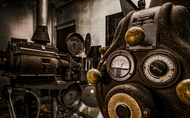Carbon Arc vs Xenon Arc: The Evolution of Cinema Illumination
Posted by Julio Urbay on 20th Jun 2025
Before the hum of digital projectors and the glow of laser light, cinema screens were lit by raw electricity and elemental fire. The story of cinema illumination is one of innovation, intensity, and the pursuit of perfect light. Two technologies—carbon arc and xenon arc—defined the golden age of film projection, each with its own brilliance and burden.
Lighting the Way: The Carbon Arc Era
Introduced in the late 1800s, carbon arc lamps were the first practical light source for large-scale projection. They worked by creating an electric arc between two carbon rods, producing a dazzling white light. But this brilliance came at a cost.
- Brightness: Carbon arcs could produce up to 10,000 lumens, but required massive power—often around 17,000 watts.
- Maintenance: Each carbon rod lasted only about 4 hours and had to be manually adjusted and replaced by a skilled projectionist.
- Color Quality: The light was warm and rich, with a smooth spectral output that many still consider superior for vintage film prints.
- Drawbacks: Dirty, noisy, and labor-intensive, carbon arcs demanded constant attention and ventilation.
Despite their challenges, carbon arcs were the standard for decades, powering everything from silent films to Technicolor epics.
The Xenon Revolution
In the 1950s, xenon arc lamps emerged as a cleaner, more efficient alternative. These lamps use high-pressure xenon gas to create a bright, continuous arc of light between two electrodes.
- Brightness: Xenon lamps produce a whiter, more sunlight-like beam with higher luminous efficiency—typically 3 to 4.5 lumens per watt, more than double that of carbon arcs.
- Longevity: Depending on wattage and usage, xenon bulbs can last between 500 and 2,000 hours, reducing labor and downtime.
- Color Temperature: Slightly cooler than carbon arcs, xenon light averages around 6000K, giving modern prints a crisp, neutral tone.
- Ease of Use: No manual trimming, no soot, and no constant adjustments—xenon lamps made projection more accessible and consistent.
By the 1970s, xenon had become the dominant light source in cinemas worldwide, and it remains the backbone of many 35mm and digital projection systems today.
Legacy and Transition
While xenon lamps brought efficiency and reliability, many archivists and purists still admire the warmth and texture of carbon arc projection. Some specialty theaters and film festivals continue to use carbon arcs for historical screenings, preserving the original viewing experience.
Today, the conversation has shifted again—toward laser projection, which offers even longer lifespans, lower energy use, and precise color control. But that’s a story for another post.

